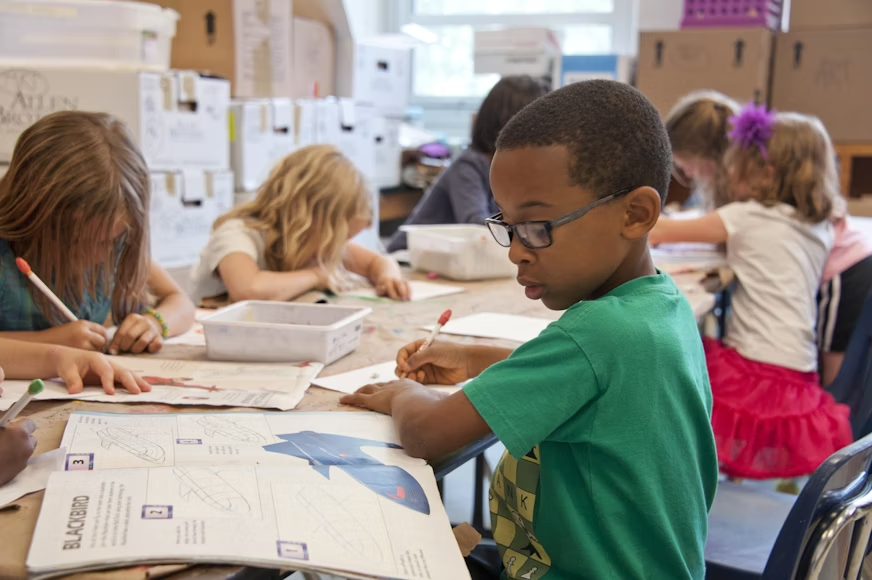
Learning & Behavior Support Programs
Curious about what’s changing in education?
Picture this. Your school or district has a rising tide of student behavior problems. Teachers are overwhelmed and classroom disruptions are on the rise. Traditional discipline methods just aren’t working anymore. Sound familiar?
The problem:
Teachers have less time than ever to focus on actual teaching. 80 percent of teachers said they have to respond to students’ behavioral problems at least a few times a week, according to a 2024 survey by the EdWeek Research Center. For schools that means a ton of precious time lost on dealing with discipline issues rather than learning and teaching.
The good news? (Yes, there’s good news!)
Schools are finally waking up to the benefits of comprehensive learning and behavior support programs that can address these issues head-on. These support programs are changing the game when it comes to education by tackling the underlying causes of behavior problems rather than just punishing students.
What you’ll discover:
- The Current State of Student Behavior in Schools
- How Modern Support Programs Are Changing Education
- The Role of Technology in Behavioral Support
- What the Future Holds for Learning Support Systems
The Current State of Student Behavior in Schools
Let’s talk about the reality of student behavior in schools right now.
Behavior problems are at the forefront of many teachers’ minds these days. In fact, 28 percent of school leaders have said that a lack of focus or inattention from students has had a major or extremely negative impact on learning during the 2023-24 school year, according to the National Center for Education Statistics.
We’re not just talking about little kids misbehaving once in a while here. The effects of the pandemic on how students interact, focus and behave in the classroom are still being felt in many schools. Teachers are dealing with everything from minor classroom disruptions to serious behavioral incidents every single day.
But here’s the kicker…
The old school punishment-based discipline methods just aren’t cutting it anymore. Pulling kids out of class with suspensions or expulsions doesn’t fix the underlying problems. It just takes them out of the learning environment and creates even more issues in the long run.
Schools need a better approach, and that’s exactly what modern learning and behavior support programs provide.
How Modern Support Programs Are Changing Education
Modern behavioral support programs are based on a whole different philosophy than the old school discipline methods.
These programs are built around three key concepts:
- Prevention — Stopping problems before they happen through setting clear expectations and reinforcing positive behavior
- Early intervention — Identifying students who need extra help and providing targeted support early on
- Individualized support — Developing individualized plans for students with more intensive behavioral needs
The most effective programs use a multi-tiered approach. That means every student gets the support they need, whether that’s basic classroom-wide strategies or more intensive, individualized help.
And the results? You don’t even believe it unless you’ve seen it firsthand.
Schools implementing these comprehensive support programs are seeing game-changing results. Students get targeted behavioral support based on their needs rather than a one-size-fits-all solution.
The Power of Evidence-Based Strategies
Okay, hold up. Before we move on, something you might not know…
Not all behavioral support programs are created equal. The best ones are backed by real science and real results.
Evidence-based strategies like Positive Behavioral Interventions and Supports (PBIS) have transformed schools across the country. These methods focus on teaching kids the right behaviors rather than just punishing them when they do the wrong thing.
The difference is night and day. When students know what’s expected of them and get positive reinforcement for meeting those expectations, behavior problems plummet.
The Role of Technology in Behavioral Support
Now let’s talk about what’s making the biggest difference right now.
Technology is a game-changer in how schools track, analyze and respond to student behavior. Modern learning support programs use powerful data systems to pinpoint patterns and intervene early.
These systems can:
- Track behavior incidents in real time
- Identify students who need additional support
- Monitor progress of interventions
- Provide teachers with actionable insights
Here’s the thing. Technology is not replacing human connections and interventions. It’s enhancing it.
Teachers are freed up from mountains of paperwork to spend more time actually supporting students. The data-driven insights allow educators to make better decisions on the right interventions for each student.Personalized Learning Environments
Personalized learning is the future, and behavioral support is no exception.
Cutting edge learning platforms are allowing schools to create personalized support plans that adapt to each student’s unique needs. These platforms consider factors like learning style, behavior triggers and individual strengths.
This kind of personalization would have been impossible a few years ago. But now it’s becoming the new normal.
Students receive support tailored specifically to them, not their classmates, not what worked for last year’s students, but what works for them.
The Integration of Mental Health Services
Schools are finally waking up to the fact that behavior problems often have root causes in mental health challenges. One in five students, about 18%, is now receiving school-based mental health services.
This blending of mental health services with educational settings is a game-changer for students. When school behavioral support programs are integrated with mental health professionals, students get the holistic care they need.
The days of addressing behavioral and mental health issues separately just doesn’t work. Students need a wraparound of support that covers all of their wellbeing.
Modern support programs include:
- On-site mental health counselors
- Regular screening for behavioral and emotional issues
- Coordination with community mental health providers
- Family support and education programs
This comprehensive approach ensures students aren’t slipping through the cracks.
What the Future Holds for Learning Support Systems
The future of learning and behavior support programs is just beginning.
- Schools will start using artificial intelligence to predict when students will need support. Predictive systems can alert school teams to risk factors before they turn into serious behavior issues.
- There will be more emphasis on family engagement. The best support programs involve parents and caregivers directly in the intervention process. (Behavioral support is most effective when it’s consistent across all environments.)
- Educator professional development will continue to grow. Teachers need training to implement support strategies effectively. Schools will invest more resources in ongoing training and coaching for staff.
Building Sustainable Systems
One key to long-term success is building systems that last.
Schools that make the investment in comprehensive behavioral support systems see benefits that far outweigh the cost in reduced discipline referrals alone. These programs improve school climate, increase academic achievement and support teacher retention.
But sustainability is key. This isn’t a one-time initiative or a quick fix.
Schools need to have dedicated leadership teams, resources and ongoing evaluation of their programs to make these investments work. The good news is more schools are making that commitment now than ever before.
Wrapping Things Up
The future of education is dependent on how schools support student behavior and learning.
The old-school discipline methods of taking kids out of class are being replaced by comprehensive support programs that address root causes and provide targeted help to individual students. These programs use evidence-based strategies, technology and are integrating mental health services.
The trends are clear:
- More schools are using multi-tiered support systems
- Technology is augmenting (not replacing) human intervention
- Mental health services are becoming the new norm in schools
- Personalized support is becoming standard
Schools that embrace these changes will be creating learning environments where all students can succeed. The investment in learning and behavior support programs will pay off in dividends of better academic results, school climate and students who are set up for success in the future.
The question is not whether schools should be implementing these programs, but how quickly can they move to this more effective way of supporting student behavior and learning.
Source link



